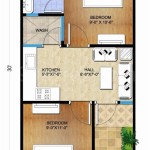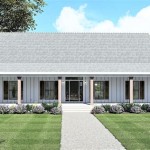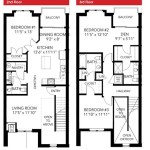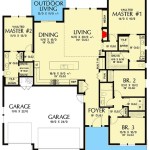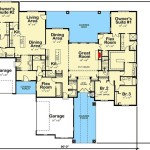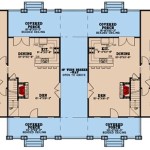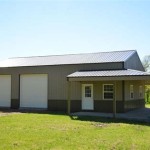Cape Cod Floor Plans: Exploring 4-Bedroom Options
Cape Cod architecture, renowned for its simple, functional design and enduring charm, remains a popular choice for homeowners seeking a comfortable and aesthetically pleasing living space. Originating in the New England region of the United States, Cape Cod homes are characterized by their steep rooflines, dormer windows, and symmetrical facades. While the classic Cape Cod design typically features a smaller footprint, modern adaptations frequently incorporate additional space and amenities, leading to the development of 4-bedroom floor plans that cater to the needs of larger families or those desiring extra room for guests, home offices, or hobbies.
This article aims to explore the various aspects of 4-bedroom Cape Cod floor plans, examining common design elements, potential layouts, and factors to consider when selecting or customizing such a plan. The discussion will focus on functionality, aesthetics, and adaptability, highlighting the versatility of this architectural style in meeting diverse lifestyle requirements.
Understanding the Core Elements of Cape Cod Design
Before delving into specific 4-bedroom floor plans, it's essential to understand the foundational elements that define Cape Cod architecture. These characteristics contribute to the style's recognizable aesthetic and functional advantages. Key features include:
Steep Roofline: The steeply pitched roof, typically with a slope exceeding 45 degrees, is a defining characteristic of Cape Cod homes. This design element was originally implemented to facilitate snow shedding during harsh New England winters. Modern adaptations retain the steep roof, often incorporating attic ventilation systems to improve energy efficiency and prevent ice dams.
Dormer Windows: Dormer windows, projecting vertically from the sloping roof, are another common feature. These windows serve multiple purposes, including increasing natural light and ventilation in the attic space, as well as adding visual interest to the roofline. Dormer windows can vary in size and style, ranging from simple gable dormers to more elaborate shed dormers.
Symmetrical Facade: Traditional Cape Cod homes exhibit a symmetrical facade, typically with a centrally located front door flanked by an equal number of windows on either side. This symmetry contributes to the style's balanced and harmonious appearance. While modern adaptations may deviate slightly from strict symmetry, the principle of balance remains a significant design consideration.
Hardwood Flooring: Hardwood flooring is a prevalent feature in Cape Cod interiors, adding warmth and character to the living spaces. Traditional hardwood options include oak, maple, and pine, while contemporary designs may incorporate engineered hardwood or laminate alternatives for increased durability and affordability.
Minimal Ornamentation: Cape Cod architecture emphasizes functionality and simplicity over excessive ornamentation. Exterior details are typically restrained, focusing on clean lines and understated elegance. This minimalist approach contributes to the style's timeless appeal.
Central Fireplace: Originally, a large central fireplace served as the primary source of heating in Cape Cod homes. While modern heating systems have replaced the traditional fireplace's sole reliance, a fireplace remains a common feature, often serving as a focal point in the living room or family room. Some 4-bedroom plans incorporate multiple fireplaces for added comfort and aesthetic appeal.
Exploring Layout Options for 4-Bedroom Cape Cod Homes
The floor plan of a 4-bedroom Cape Cod home can vary depending on the overall square footage, the homeowner's preferences, and the specific site conditions. However, certain layouts are more common and lend themselves well to the Cape Cod aesthetic. Here are a few potential layout options:
Traditional One-and-a-Half Story: This classic layout features the main living areas, including the kitchen, living room, and a primary bedroom, on the first floor. The remaining three bedrooms are located on the second floor, accessed via a staircase. Dormer windows are crucial in this design, providing natural light and headroom in the upper-level bedrooms.
Expanded One-Story Ranch: In this variation, the Cape Cod elements are incorporated into a ranch-style design. All four bedrooms are situated on the main floor, offering single-level living. This layout is particularly suitable for homeowners seeking accessibility or preferring to avoid stairs. The exterior retains the characteristic steep roof and dormer windows, adapting them to a larger, more sprawling footprint.
Two-Story Cape Cod: While less common, a two-story Cape Cod design provides increased living space and allows for a more flexible floor plan. The bedrooms can be distributed across both floors, providing opportunities for creating distinct living zones. For example, the primary bedroom suite could be located on the first floor for added privacy, while the remaining bedrooms are situated on the second floor.
Adaptations with Finished Basements: Some 4-bedroom Cape Cod homes incorporate a finished basement to further expand the living space. The basement area can be used for a variety of purposes, such as a recreation room, home theater, or additional bedrooms. A finished basement can significantly increase the overall value and functionality of the home.
Regardless of the specific layout, careful consideration should be given to the placement of the bedrooms, bathrooms, and living areas to optimize flow and functionality. A well-designed floor plan will ensure that the home is both comfortable and efficient to live in. The positioning of staircases, hallways and entryways can dramatically impact how the house feels overall.
Key Considerations When Selecting a 4-Bedroom Cape Cod Floor Plan
Choosing the right 4-bedroom Cape Cod floor plan involves careful consideration of several factors. These factors relate to the homeowner's lifestyle, budget, and site conditions. Understanding these considerations can help ensure that the selected plan meets the homeowner's specific needs and expectations.
Family Size and Lifestyle: The size and composition of the family will significantly influence the optimal floor plan. A larger family may require more bedrooms and larger living areas, while a smaller family may prioritize open-concept living spaces and fewer bedrooms. Consider the specific needs of each family member when evaluating potential floor plans. The ages of the children, the work-from-home needs of the adults, and the entertainment habits of all family members should be considered, along with any special needs requirements. Future needs should also be taken into account.
Budget: The budget is a crucial consideration when selecting a floor plan. The size and complexity of the design will directly impact the construction costs. It's essential to establish a realistic budget and choose a floor plan that aligns with those financial constraints. Consider the cost of materials, labor, and any necessary site improvements. Building additional dormers, adding complex rooflines, and incorporating custom features will all increase costs. The cost of finished basement space can also be considerable.
Site Conditions: The characteristics of the building site can also influence the selection of a floor plan. The topography, soil conditions, and orientation of the lot can all affect the design and construction process. For example, a sloped lot may lend itself well to a walk-out basement, while a flat lot may be more suitable for a one-story ranch-style design. The orientation of the lot relative to the sun can affect heating and cooling costs. A qualified architect or builder can assess the site conditions and provide recommendations for the most appropriate floor plan.
Energy Efficiency: Modern building codes prioritize energy efficiency, and it's essential to consider this factor when selecting a floor plan. A well-designed home will minimize energy consumption through proper insulation, efficient windows and doors, and optimized HVAC systems. Consider incorporating energy-efficient features such as solar panels, tankless water heaters, and smart thermostats. The placement of windows and orientation of the home can greatly impact heating and cooling costs. A smaller home with a properly designed heating and cooling system can be much more energy-efficient than a larger, poorly designed one.
Future Resale Value: While the primary focus should be on selecting a floor plan that meets the homeowner's current needs, it's also important to consider the potential resale value of the home. A well-designed and properly maintained Cape Cod home can retain its value over time, making it a sound investment. Consider the features that are most desirable to potential buyers in the local market. Homes with desirable features such as energy-efficient appliances, modern kitchens, and updated bathrooms tend to sell more quickly and for a higher price. Also consider the location of the property within the neighborhood. The resale value is significantly affected by the neighborhood's market dynamics. A home built with high-quality materials that conforms to local standards will retain more value in the long run.
Customization Options: The ability to customize a floor plan is an important consideration for many homeowners. A flexible design allows for personalization and ensures that the home meets the specific needs and preferences of the occupants. Consider the potential for future renovations or additions. A floor plan that allows for easy modifications can adapt to changing needs over time. Common modifications include adding a sunroom, expanding the kitchen, or finishing the basement. The ease of customization can increase the appeal and long-term value of the home.
By considering these factors, prospective homeowners can make informed decisions when selecting a 4-bedroom Cape Cod floor plan that meets their needs and expectations. A thoughtful approach to planning and design will result in a comfortable, functional, and aesthetically pleasing home that will be enjoyed for many years to come.

Cape Cod House Plan With 4 Bedrooms And 2 5 Baths 3047

Cape Cod House Plan With 4 Bedrooms And 3 5 Baths 5423

Cape Cod Floor Plans Key Modular Homes

Cape Cod Floor Plans Key Modular Homes

House Plan 61470 Southern Style With 2796 Sq Ft 4 Bed Bath
Cape Cod House Plan 4 Bedrms 1 0 Batj 564 Sq Ft 157 1618

House Plan 4 Bedrooms 2 Bathrooms Garage 3274 Drummond Plans

Ham Cape Cods Modular Home Floor Plan The Plans House
Cape Cod House Plan 4 Bedrms 1 0 Batj 564 Sq Ft 157 1618

Cape Cod House Plans

